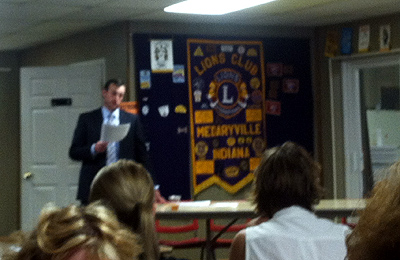The event also included a celebration of Pulaski County's entrepreneurial culture, insight from successful entrepreneurs in Pulaski County and a catered meal. About 20 persons attended.
The substance of Origer's speech follows:
2012 State of the County Economy
Speech by Nathan Origer, PCED Director
In many respects, ours is a pretty healthy local economy. Our official unemployment rate, 6.2 percent for May, has consistently been one of the best in the state, currently 10th-best out of 92. Not only has it improved to this low level in recent months, but it has done so as the size of the labor force has grown; that is, both the number of people who “count” and the number of that group who are employed have increased. Everything else disregarded, you can’t deny that this is a good sign. And it’s not surprising. As I noted, ours is a diversified, homegrown economy. An over-reliance on one sector, or a heavy concentration of absentee-owner companies, makes a community’s economy more susceptible to wreckage in rough times. We’ve been fortunate.
 Despite the worrying trends globally and nationally, we’ve seen some healthy growth just in the time that I’ve been in this position. Apparently, I came in at the opportune time!
Despite the worrying trends globally and nationally, we’ve seen some healthy growth just in the time that I’ve been in this position. Apparently, I came in at the opportune time!
Anyone who’s travelled U.S. 421 south of Francesville has surely noticed the major changes at Remington Seeds. An almost $20-million project, this is leading to 8 to 10 full-time and at least as many part-time jobs — jobs that will be well beyond full-time for the nine or 10 months of the year when they exist. FRATCo has added nearly 15 jobs over the last year in Francesville with expansions, in addition to the acquisition of a third plant, in Iowa, and the continued operation of their second plant, in Illinois. The Braun Corporation recently unveiled a new taxi line, and recapitalization efforts there have brought in fresh, new ownership and offer our community the security of a long-term commitment to do business here. The lots at both GalFab and Galbreath/Wastequip are full of trucks waiting to be equipped.
The Town of Winamac, the county, and Plymouth Tube are close to reaching a formal agreement on the financing of a new (electric) substation. Once this new power source is feeding the Hot Mill, there’s significant potential for a $45-million expansion, one expected to add about 20 jobs. Whether or not the proposed expansion occurs, this substation will free up the existing substations so that opportunities for growth exist at all three mills. Infrastructure really is the name of the game.
On a smaller — and admittedly more tendentious — scale, our county still has a lumberyard, thanks to the county’s Revolving Loan Fund. The bottom line is that, though viewed skeptically by many, for one reason or another, this loan, made with money explicitly held by the county for such purposes, retained a few jobs; kept open our only building-supply store, and has kept local contractors’ money in the community — as well as some money spent by contractors brought in by companies like Plymouth Tube. Recently celebrating 25 years in business, Link Environmental Equipment is on the cusp of expansion in two new retail directions.
And don’t forget tourism! Please, don’t. Our young and growing Panhandle Pathway (And who wouldn’t like to see a trail on this side [west side] of the county someday?), Jasper-Pulaski and those ever-popular cranes, the state park and gorgeous Tippecanoe River, the Winamac Fish-and-Wildlife Area, our campgrounds, golf courses, and smaller attractions all bring people to Pulaski County, people who spend money here. Yes, ours is a healthy local economy.
Or is it?
An official unemployment rate of 6.2 percent translates to something closer to seven, or, really, even 11, percent, depending on whom we include. This means that as many as 800 people in Pulaski County are out of work or underemployed. Despite this, I still hear from employers who cannot fill open positions. Some applicants fail the drug screen; some forget that if the shift starts at 8 a.m., then they need to be ready to go then, not at 8:30 or 10 — or the next day. Even if they’re drug-free, able to show up on time, and ready to work, they don’t always have the necessary skills. We need to step it up on this front.
A study released earlier this year by the Annie E. Casey Foundation revealed that Pulaski County, at 38 percent, has the highest rate of children living in concentrated poverty of any Indiana county. The level for Indiana is 8 percent, and nationally, we’re at 11 percent. But 38 percent here in Pulaski County, that’s sad. We certainly don’t have the most people living in poverty. But just as one factor of a small population and aging demographics is a lower unemployment rate, so, too, is this unpleasant blemish. At 14.2 percent, the portion of our population living in poverty is below the state level of 15.3 percent, but our median household income of about $42,000 is below the state’s almost $46,000.
Less well-known, but more damning, is what’s called the “Community Distress” score, which is calculated by the Indiana Office of Community and Rural Affairs and used in scoring grant applications. This number, ranging from 0 at best to 175 at worst, is based on factors including poverty rate and median household income, housing vacancies and median home values, and the unemployment rate and labor-force participation.
The current worst score of any county in Indiana is 153.86; the absolute best is 4.93, with most of the lowest scores hovering about 20. With a score of 109.15, Pulaski County is ranked 15th — 15th-worst, remember — of 92 counties. Among 20 nearby counties, only two have higher scores. This is helpful if we’re applying for a state grant, but otherwise this (isn’t) good.
Take nothing for granted
Even our current economic successes cannot be taken for granted. Remington Seeds, FRATCo, and numerous other ag-service businesses (to say nothing of farmers themselves) have benefitted from the agricultural boom of recent years. For how long will this trend continue? Will we see the land bubble burst? How long-term will the damages from this drought be? Farmers are resilient and innovative people, so I’m not terrified, but we certainly shouldn’t be counting any chickens before they hatch — or eggs before Rose Acres packages them.
Plymouth Tube’s Winamac successes rely heavily on the oil and gas industries; the unpredictability of domestic policy, innovations in various alternative-fuel technologies, and variability in market demand - depending on the frigidity or mildness of any given winter - will all continue to affect the company’s production. This is a strong company, and I have no doubt that they’re flexible enough in the long-run, but I take nothing for granted.
Anyway, back to those 7,000 or so residents who are gainfully employed. About 20 percent of them work outside of Pulaski County. This, of course, is not all bad. We have in-commuters who contribute to our successes just as we have out-commuters who are employed elsewhere, sometimes because that’s just where the suitable positions are. We’re never going to have 100 percent of our residents employed in-county, and it would be silly to aim for that. Just the same, labor exportation does have some deleterious ramifications. Consider:
- The financial and environmental impact of the gas used to get from Pulaski County to out-of-county employers and back.
- The personal, social, and civic sacrifices that stem from spending more time in the car and less with family, friends, and fellow residents.
- The greater likelihood of money being spent at out-of-county stores rather than locally, just because of the convenience.
Support for Downtowns
When we adjourn tonight, look down Main Street. Drive over to Main Street, Monterey, and see how dismal things look. Even in Winamac, Market, Pearl, and Main Streets are shells of what they once were, as the town has sprawled, especially northward — thereby leaving well-built, attractive, and historic buildings to decay while funds have had to be spent to extend utilities to unattractive buildings fronted not by public streets and sidewalks, but acres of pavement. Really, only Francesville has what we can really call a thriving downtown, and, nice and busy as it is, it’s not exactly a metropolis. This is a shame.
There’s certainly room, in our car-reliant era, for the Winamac Plazas of the world, but downtown is, and must be, the heart of any community. Our towns need, need, need retail revitalization, period, whether along the highways or, preferably, downtown. That’s tough, of course. It requires not only the undertaking — the entrepreneurship, to provide the meaning of this French word — of risk by the fledgling business owners, but also community support. If someone opened a grocery store in Medaryville, would locals support it, or would the “too-high prices” still send folks elsewhere? Saving money, especially when the economy is as it is, is always desired, but at what cost? We all need to ask ourselves this. Remember what I said about local spending (and hiring!) and community health.
It takes community support, and it also takes support from organizations like PCED. I’m all for letting the market work — although there are more important rules in community life and society than market principles! — but our national economy evinces that the rules of supply and demand, of risk and reward, have been run over roughshod by bad government intervention, which, instead of creating rules, framework, and a level playing field, has pre-determined winners and losers. A stronger case absolutely can be made for local- and even state-government involvement in the local economy than for Washington-DC cronyism, and we need it now, perhaps more than ever. We are right to be proud of Pulaski County and all that it offers, our employers, our workforce ... but, clearly, there’s work still to be done
So, now what?
At PCED, we must continue, with renewed vigor, to implement our strategic plan: work to develop the ag-/alternative-energy–oriented industrial park; do everything that we can to make sure that CSX looks at our lone railroad as an asset, and not a liability; pick up the slack on the workforce-development front, whether through training programs, assistance to local employers, or just more effective dissemination of information; and do everything that we can to help operating and budding entrepreneurs to add value to their own lives and to this great community that we call home, Pulaski County — through our Revolving Loan Fund; working with resources like the SBDC, SBA, and Chamber; and events like tonight’s - preferably with more entrepreneurs in attendance next time.







